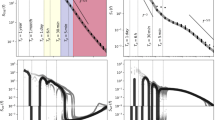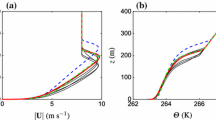Abstract
A second-order modelling technique is used to investigate the influence of turbulence on chemical reactions. The covariance and variance equations for the NO-O3-NO2 system are developed as a function of the ratio of the timescale of turbulence (τ t ) and the timescale of chemistry (τCh): the first Damköhler number (τ t /τCh). Special attention is given to the calculation of the covariance between NO and O3 normalized by the product of their means, the so-called intensity of segregation (I S ). This parameter quantifies the state of mixing of two chemical species.
The intensity of segregation is calculated as a function of the flux of NO and the first Damköhler number. The model results presented illustrate the importance of taking the effect of turbulence on chemical reactions into account for higher values of the NO flux, for values of the ratio O3/NO larger than 12.5 and for values of the ratio τ t /τCH larger than 0.1. For such cases, the effective reaction rates are slower than if the chemical species are assumed to be uniformly mixed.
Similar content being viewed by others
References
Bilger, R. W., 1989, Turbulent diffusion flames,Ann. Rev. Fluid Mech. 21, 101–135.
Builtjes, P. J. H. and Talmon, A. M., 1987, Macro- and micro-scale mixing in chemical reactive plumes,Boundary-Layer Meteorol. 41, 417–426.
Caughey, S. J., Wyngaard, J. C., and Kaimal, J. C., 1979, Turbulence in the evolving stable boundary layer,J. Atmos. Sci. 6, 1041–1052.
Csanady, G. T., 1973,Turbulent Diffusion in the Environment, D. Reidel, Dordrecht, The Netherlands.
Danckwerts, P. V., 1952, The definition and measurement of some characteristics of mixtures,Appl. Sci. Res. A3, 279–296.
Donaldson, C. du P. and Hilst, G. R., 1972, Effect of inhomogeneous mixing on atmospheric photochemical reactions,Environ. Sci. Technol. 6, 812–816.
Fitzjarrald, D. R. and Lenschow, D. H., 1983, Mean concentration and flux profiles for chemically reactive species in the atmospheric surface layer,Atmos. Environ. 17, 2505–2512.
Georgopoulos, P. G. and Seinfeld, J. H., 1986, Mathematical modeling of turbulent reacting plumes. I General theory and model formulation,Atmos. Environ. 20, 1791–1807.
Gao, W., Wesley, M. L., and Lee, I. Y., 1991, A numerical study of the effect of air chemistry on fluxes of NO, NO2 and O3 near the surface,J. Geophys. Res. 96, 18,761–18,769.
Hong, M. S. and Carmichael, G. R., 1983, An investigation of sulfate production in clouds using a flow-through chemical reactor model approach,J. Geophys. Res. 88, 10,733–10,743.
Ibrahim, S. S., Bilger, R. W., and Mudford, N. R., 1987, Turbulence effects on chemical reactions in smog chamber flows,Atmos. Environ. 21, 2609–2621.
Janssen, L. H. J. M., Nieuwstadt, F. T. M., and Donze, M., 1990, Time scales of physical and chemical processes in chemically reactive plumes,Atmos. Environ. 24A, 2861–2874.
Komori, S., Hunt, J. C. H., Kanzaki, T., and Murakami, Y., 1991, The effects of turbulent mixing on the correlation between two species and on concentration fluctuations in non-premixed reacting flows,J. Fluid Mech. 228, 629–659.
Nieuwstadt, F. T. M., 1984, The turbulent structure of the stable, nocturnal boundary layer,J. Atmos. Sci. 41, 2202–2216.
Panofsky, H. A. and Dutton, J. A., 1984,Atmospheric Turbulence, Wiley, New York.
Schumann, U., 1989, Large-eddy simulation of turbulent diffusion with chemical reactions in the convective boundary layer,Atmos. Environ. 23, 1713–1727.
Vilà-Guerau de Arellano, J. and Duynkerke, P. G., 1992, The influence of chemistry on the flux-gradient relationships in the NO-O3-NO2 system,Boundary-Layer Meteorol. (in press).
Vilà-Guerau de Arellano, J., Duynkerke, P. G., Jonker, P. J., and Builtjes, P. J. H., 1992a, An observational study on the effects of time and space averaging in photochemical models,Atmos. Environ. (in press).
Vilà-Guerau de Arellano, J., Duynkerke, P. G., and Builtjes, P. J. H., 1992b, The divergence of the turbulent diffusion flux due to chemical reactions in the surface layer,Tellus B (in press).
Vilà-Guerau de Arellano, J., Talmon, A., and Builtjes, P. J. H., 1990, A chemically reactive plume model for the No-NO2-O3 system,Atmos. Environ. 24A, 2237–2246.
Wyngaard, J. C., 1982, Boundary-layer modeling, in F. T. M. Nieuwstadt and H. van Dop (eds.),Atmospheric Turbulence and Air Pollution Modelling, D. Reidel, Dordrecht, The Netherlands.
Wyngaard, J. C., Coté, O. R., and Rao, S. R., 1974, Modeling the atmospheric boundary layer,Adv. Geophys. 18A, 193–212.
Wyngaard, J. C. and Coté, O. R., 1971, The budgets of turbulent kinetic energy and temperature variance in the atmospheric surface layer,Boundary-Layer Meteorol. 9, 441–460.
Zeman, O., 1981, Progress in the modeling of planetary boundary layers,Ann. Rev. Fluid. Mech. 13, 253–272.
Author information
Authors and Affiliations
Rights and permissions
About this article
Cite this article
Vilà-Guerau de Arellano, J., Duynkerke, P.G. Second-order closure study of the covariance between chemically reactive species in the surface layer. J Atmos Chem 16, 145–155 (1993). https://doi.org/10.1007/BF00702784
Received:
Revised:
Issue Date:
DOI: https://doi.org/10.1007/BF00702784




